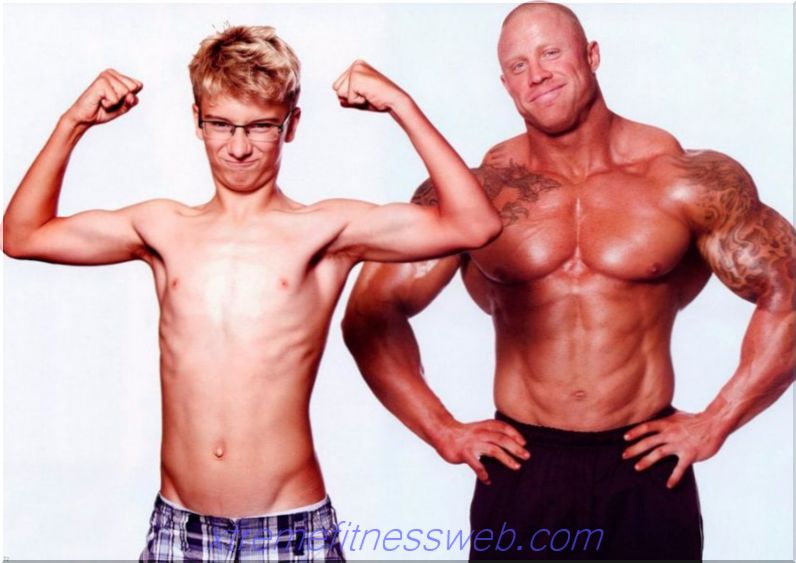
A classic dumbbell bench press on an incline bench is an exercise for developing chest muscles. This basic movement has been known since the golden era of bodybuilding. Dumbbells began to reap earlier than the barbell. Many bodybuilders consider the movement more beneficial for building outstanding volumetric muscles than the bench press, because the muscles work with dumbbells at a fuller amplitude. Individuals, however, manage to say that beginners should not press a dumbbell, but only need to work in simulators. But in fact, there is nothing complicated in this exercise. It is only important to learn how to do it right from the very beginning.
Content
- 1 The right technique
- 2 Recommendations
- 3 Analysis of exercises
- 3.1 working muscles
- 3.2 Pros of the dumbbell bench press
- 3.3 Cons of the dumbbell bench press
- 4 Proper execution
- 4.1 Errors
- 4.2 Performance Tips
- 5 Inclusion in the program
The right technique

It would seem that it could be simpler - we put the back on a slope of 30 degrees, sit on a bench, dumbbells in our hands, lower ourselves, press the shoulder blades and pelvis, bring the dumbbells up, lower, squeeze. But even here there are “platforms for discussion”:
- Some trainers consider the bench press a dumbbell to be a technical error if the back is in a natural deflection. They consider this deflection to be an analog of the lift "bridge" and say that this does not allow pumping up the chest;
- Others argue that when reducing the shoulder blades and lowering them to the floor, and rigid fixation of the pelvis, it does not matter where the athlete’s lower back is located. There is no particular sense in its “violent” pressing against the bench. But the heads of the shoulders, looking forward - this is a violation of the anatomical plane of the joint, and the cause of injuries
Does the chest work if the lower back is torn from the bench "> 
Technically, the bench press runs like this:
- The athlete sits on the bench, brings the shoulder blades and removes the shoulders from the ears;
- Then he rests in the starting position;
- The assistant helps to bring the dumbbells to the level of the line passing through the plane of the middle of the chest;
- Dumbbell vultures are perpendicular to the spine, grip straight and closed;
- The wrists are excluded;
- On inhalation, the dumbbells descend to the lower point of the amplitude, as close as possible to the point at which the bar of the bar could lie on the chest with the bench press;
- On exhalation, you need to consciously strain the chest, and push the dumbbells up;
- Another controversial issue is the position of the elbows. Unbend completely or leave slightly bent ">
Recommendations

In order to achieve a harmonious development of the chest muscles, both dumbbells should be lowered evenly so that the movement does not require the use of the front deltas to align the shells. If the athlete can not work evenly, it is worth following the posture. With scoliosis, it is recommended to press first with one hand, and then with the second. The free hand is pressed against the body, or displayed with a dumbbell up, if the weight of the projectile allows you to do this.
Dumbbell weight selection is the most “painful” topic for beginners. After all, it is the bench press that serves as a measure of strength indicators and success in the hall. Therefore, many grab the heaviest dumbbells, and try to reap them with all possible violations of technology. This is a big mistake. Basic dumbbell movement is only effective if used in the technically correct way. “Skewed” bench presses do not lead to anything other than an injury to the wrists and shoulders.
The exercise is performed with the help of the insurer, this is a more rational option. Squeezing very light dumbbells of 10-12 kg does not make sense, for men with average physical development and weighing from 70 kg, you can start with 18-20 kg for 8 repetitions, or use a slightly lower weight at the workout, and gradually increase it to work approaches.
Movement should not be carried out with an open grip when the thumb does not clasp a dumbbell bar, and shells can slide.
Does it make sense to briefly reduce the dumbbells at the high point of the exercise amplitude, as some bodybuilders advise doing ">
Parsing exercise

Working muscles
The main mover is the major and minor chest muscles, triceps and anterior deltoid. The biceps, back muscles, and partly dentate and trapezius muscles help the movement. The legs work like stabilizers.

Pros of dumbbell bench press
The exercise does not require special preparation, if the biomechanics of the upper body are violated, you can perform a bench press with light dumbbells, even if the elbows bend differently, or partially innervated, or damaged chest muscles. Therefore, dumbbell presses are often included in rehabilitation programs.
The movement allows you to balance the development of the right and left half of the body, which is important both for aesthetics in bodybuilding, and for power in the bench press and powerlifting. The dumbbell press will save you from the distortions of the bar in the classical bench press, and will help to more actively include the neuromuscular connection at the breakdown from the chest.
Dumbbell bench press helps to work out the "top" of the chest, which is important for women who want to have a good shape. Exercise is not able to distort the shape of the breast, or somehow affect the mammary gland itself, therefore it can be safely performed by everyone who wants to improve their physical shape.
The movement allows you to perform work at a greater amplitude, actively involving the muscles of the chest, and not just triceps and deltas. In this sense, the dumbbell bench press on an inclined “better” bench press, and can replace it for purposes related to body aesthetics.
Cons of dumbbell bench press

Movement is difficult to perform if there is a curvature of the spine in the thoracic region. In this case, push-ups, push-ups from the platform, loops, supports, or bench presses in the simulator are sitting.
Dumbbells can and should be pressed, actively straining the muscles of the back and legs, if this is not yet available, you should choose exercises in the simulators.
It’s difficult to take heavy weight alone, you need a belay, and for high-level athletes, two assistants.
But the most important minus of the exercise is not in himself, but in equipment that is purchased for fitness clubs. For people taller than 180 cm tall, the standard fitness bench is too low, and therefore it is almost impossible to take the correct starting position. In case it is not convenient to reap because of growth, it is worth adjusting the position of the bench, putting pancakes for the bar under the stops.
Correct execution

You can control yourself by the following parameters:
- The athlete touches the bench with the back of the head, shoulder blades and pelvis;
- Shells descend into a line passing through the center of the chest, and can rise to the line of clavicles;
- The bench path is not linear, but elliptical;
- During movement, weight pushing, unintentional pauses over the entire amplitude, and active assistance to oneself by the body are excluded;
- The exhalation is carried out by effort, while inhaling, it is necessary to lower the dumbbells, as if opening the chest;
- Shoulders and elbows need to be tightly controlled to prevent their “kink” and unnatural trajectory.
Mistakes
Technical errors in the dumbbell bench press - is the projection of the shells to both the eyes and the stomach, uneven bench press, dumbbell displacement and not a hard grip.
A separate category of errors arises due to the fact that the athlete’s legs slip, or he freely places them on the floor, refusing to fix it rigidly.
Performance Tips
It is necessary to monitor the trajectory of the dumbbells, choose for yourself shells adequate to the training level of weight, and do not forget that the mechanics of movement consist of lowering and lifting, and an error in lowering (too high or low) can cause a violation of the trajectory of the bench.
Program Inclusion

For a bodybuilder or fitness, this may be the first exercise that builds both muscle mass and volume. The movement is performed in 8-15 repetitions, sometimes 4-6 repetitive sets are also practiced to develop strength.
If the movement is included in the program after the bench press, 12-15 repetitions are allowed. The number of working approaches depends on the level of the athlete. It is advisable to make them at least 2-3, more - it is possible if the athlete is recovering normally.
The bench press of dumbbells allows you to not only build aesthetic muscles of the chest, but also strengthens the shoulder joints when properly performed. Follow the technique and you will achieve your training goals.













